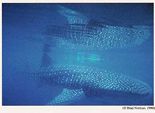
LIVING TREASURES
| Cetaceans | Turtles | Dugong | Manta Rays |
Fish | Coral | Seagrasses | Flora | Molluscs | Sharks | Fauna | Marsupials | Birds | The Secret World |
The whale shark is the largest living shark. It is one of the three filter-feeding species of shark, with a broad, flattened head and minute teeth. It also has a distinctive patterning of light spots and stripes over a dark background, fading to a light colour on the underside. This natural camouflage allows it to �blend� into its surroundings when viewed from any angle. The ecotourism industry revolving around the whale sharks at Ningaloo Marine Park was fully established by 1993. It has burgeoned to become a huge economic boon to the economy of the region. Research was initiated to determine the impacts of ecotourism activities in the whale shark resource at NMP. (see more ...)
Within Ningaloo Marine Park six species of toothed whales, eight species of baleen whales and two species of dolphins have been sighted. Humpback whales migrate twice annually through the reef waters, other frequenters of the Ningaloo area include the minke, southern right and blue whales. These mammals, threatened by overexploitation and destruction of their Indo-Pacific habitat find a safe and healthy marine habitat at Ningaloo. (see more...)
Of the seven marine turtle species in the world, six are found in Australian waters and four of these are found in the Ningaloo marine tract area. These are the Leatherback, Green, Loggerhead and Hawksbill turtles, all classified as vulnerable or endangered under the IUCN and the EPBCA Act (Environment Protection and Biodiversity Conservation Act 1999). Some of these threatened turtle species are known to be residents of this coastline all year round, they regularly nest on beaches in Bateman Bay. These vulnerable creatures will be strongly effected by a marina development right on their nesting ground. (see more...)
Northern Australia has the last significant Dugong population in the world. The delicate seagrass ecosystems along the coastline are vital refuge areas for Dugongs to feed and mate. This includes the area of Batemans Bay near Maud's landing. According to 1989/1994 surveys, the Ningaloo Marine Park had a population of 1000 dugongs, distributed across the whole Ningaloo reef tract. (Preen, Marsh, Lawler, Prince, Shepherd 1997). (see more...)
Manta Rays occur widely in front of proposal. Aggregations of up to 100 animals are reported. Anecdotal evidence (there is little scientific research on mantas at Ningaloo yet) point to Maud's landing as having the most consistent manta interactions on the Ninagloo coast in shallow water inside the reef . This is unique to Point Maud as mantas are usually found on the ocean side of the reef. A witnessed mating sequence suggests that it could be a mating ground. They are totally protected under the Fisheries Resource Management Act. (see more...)
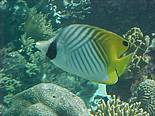 The
fish species in the Ningaloo reef area are incredibly varied and abundant, with
about 500 species, this is because of the undisturbed, isolated state of Ningaloo.
The
fish species in the Ningaloo reef area are incredibly varied and abundant, with
about 500 species, this is because of the undisturbed, isolated state of Ningaloo.
As the area is also a unique biogeographical overlap zone, the fish species
are diverse, including warm-temperate, sub-tropical and tropical species. Indeed,
some of the fish species found at Ningaloo are not found anywhere else in the
world.
There are four fish species that have been recognised and are totally protected under the Fisheries Resource Management Act.
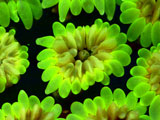 The
Coral Coast Resort ironically, is most likely to increase the gradual destruction
of the coral communities in the Ningaloo area. This is because the reef is a
fringing reef. We've seen the gradual death to coral life on the Great Barrier
reef, well, Ningaloo reef is even closer and more accessible and thus far more
vulnerable to human impacts. Despite the best intentions, corals will be affected
by boating activities and mooring, and trampled by people reef walking.
The
Coral Coast Resort ironically, is most likely to increase the gradual destruction
of the coral communities in the Ningaloo area. This is because the reef is a
fringing reef. We've seen the gradual death to coral life on the Great Barrier
reef, well, Ningaloo reef is even closer and more accessible and thus far more
vulnerable to human impacts. Despite the best intentions, corals will be affected
by boating activities and mooring, and trampled by people reef walking.
The corals from Ningaloo reef actually act as a vital source of coral larvae
dispersing through the Abrolhos Islands and even to Rottnest Island. If the
resort went ahead the negative long-term impacts would certainly be far-reaching.
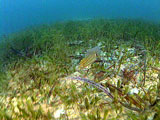 There
are three main seagrass species found around the coast at Ningaloo, these are
from the Posidonia, Amphibolis and Halophila genuses. These provide important
nursery grounds and 'hide-outs' for fish and other marine creatures, and are
also a vital food source for Dugongs. Seagrass is vulnerable to changes in the
water quality, such as increased turbidity and nutrient enrichment, and to damage
from boat anchorage thus the seagrass beds are at risk of depletion. Particularly,
because the beds are located in patches around Bateman bay, rather than large
beds, their rate of recovery would be decreased. (see
more...)
There
are three main seagrass species found around the coast at Ningaloo, these are
from the Posidonia, Amphibolis and Halophila genuses. These provide important
nursery grounds and 'hide-outs' for fish and other marine creatures, and are
also a vital food source for Dugongs. Seagrass is vulnerable to changes in the
water quality, such as increased turbidity and nutrient enrichment, and to damage
from boat anchorage thus the seagrass beds are at risk of depletion. Particularly,
because the beds are located in patches around Bateman bay, rather than large
beds, their rate of recovery would be decreased. (see
more...)
Flora and Vegetation The flora of the Cape Range Peninsula is incredibly diverse with over 630 plant species recorded. It is much more diverse than similar arid and semi-arid areas in Western Australia and is known to have twice as many species as other similar areas within the same biogeographic region. Many species in the Cape Province are at the end of their geographic range and are hence considered extremely important from an ecological perspective. The peninsula is also a region of biogeographic overlap and therefore has a diversity of species from temperate, arid and tropical botanical provinces. (see more ...)
Over 600 species of mollusc have been reported in the area.
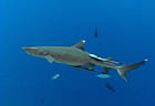 |
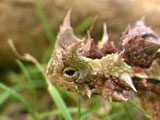 |
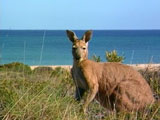 |
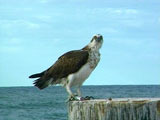 |
The Secret World of Cape Range
Hidden from view beneath the arid exterior of Cape Range peninsula lives an extraordinary collection of cave-dwelling and aquatic animals found nowhere else in the world. These subterranean creatures are a remarkable living time capsule echoing past changes in sea level and climate, and offering a window to the time of Gondwana.
The habitat for these unique animals is the 'karst' of Cape Range - a massive system of sinkholes and caves etched over millions of years out of the limestone formations that make up much of the peninsula. The caves provide a cool humid atmosphere for an amazing diversity of terrestrial animals, called 'troglobites', adapted over eons to an underground existence. Below the caves lies a vast freshwater aquifer, salty at its edges under the coastal plain from tidal movement of seawater up to 3.5 km inland from the adjacent Ningaloo Reef. This aquifer and salty interface is the home for yet another unique group of underground aquatic animals, collectively known as 'stygofauna'.
The
troglobites and stygofauna are of particular significance because of their remarkably
different
origins and because of what this reveals about the history of the area. Amazingly,
the closest living relatives of the aquatic stygofauna are in the Caribbean
region and the Canary Islands off Africa. This extraordinary distribution of
relatives suggests a common origin over 180 million years ago, when the ancient
supercontinent of Pangea, on the shores of the Tethys Sea, broke up. As the
landmass forbears of today's continents, amongst them Gondwana, began drifting
apart, they carried these common ancestors with them, including the ancestors
of the stygofauna of Cape Range.
In contrast to the stygofauna, the closest living relatives of the cave troglobites are animals found in the litter on the floor of tropical and southern temperate forests of Australia. Cape Range is now an arid area, but the troglobites show that wet and humid conditions and rainforest must have existed there within the past 20 million years, when the Cape Range formation was deposited and the caves began to form. Some of the forest floor animals must have been driven underground as the area became progressively more arid. Having persisted in these caves long after climatic changes eliminated their surface ancestors, they are a living reflection of past climates. They became permanent cave dwellers and began evolving adaptations to a strictly subterranean life, such as loss of eyes, wings and pigment, or elongation of feelers.
The karst system of Cape Range is already renowned for having one of the most diverse and species rich subterranean faunas in the world, even though most of the secret lives hidden there still remain to be discovered. Amongst the animals found so far are amphipods, shrimps, snails and millipedes, schizoids and spiders, archaeognaths, thysanurans and fish. Of these 54 species, 10 genera and at least one class occur nowhere else. The cave systems also support many other spiders, millipedes and molluscs which are evolving adaptations towards underground life. These species and their true subterranean cousins contribute to the complexity of cave communities, which are thought to be the richest and most diverse of any karst system in the world.
At present, 11 species of the subterranean fauna are considered rare or likely to become extinct, and are listed under the Western Australian Wildlife Conservation Act. It is likely that many more from the area will be similarly recognised and protected in the future.
The astounding level of endemic species and community complexity comes from evolution progressing in a unique habitat isolated from comparable ones elsewhere in the world. But similar processes are happening within Cape Range itself. At this finer scale, the Cape Range caves function like an archipelago of islands, separated from each other by distance or conditions inhospitable to the cave occupants. As a consequence, animals within individual caves are becoming adapted to and dependent on the specific conditions of their particular caves, and are evolving away from their relatives in adjacent caves.
Both the troglobites and stygofauna can only survive if their unique habitats are preserved. The rich cave fauna is ultimately dependent on the presence and maintenance of the limestone karst system of the peninsula as a whole, and of individual caves. But it also depends on the surface plants and animals, from where food sources are derived and carried into the caves with rainfall. Similarly, the stygofauna lives a precarious existence dependent on maintenance of the aquifer and the quality of its waters, and of the waters of the adjacent reef system.
The potential to destroy or to protect the karst and its inhabitants rests on our decisions.
download
- THE EXTRAORDINARY CAPE RANGE
AREA, WA
A 4 page brochure produced by
the Australian Marine Conservation Society and the Australian Conservation Foundation.
133kb as PDF
| Cetaceans | Turtles | Dugong | Manta Rays |
Fish | Coral | Seagrasses | Flora | Molluscs | Sharks | Fauna | Marsupials | Birds | The Secret World |